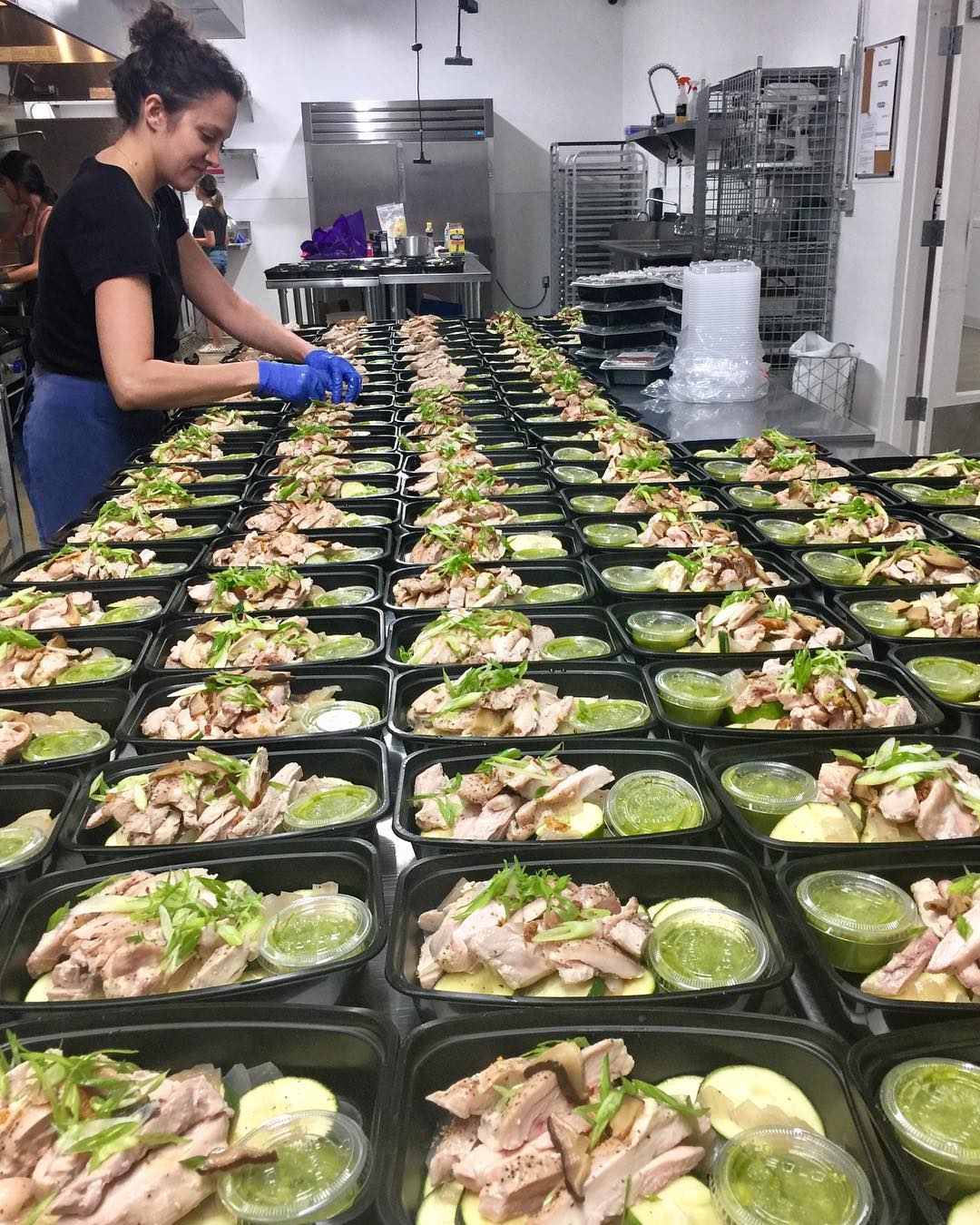Kitchen incubators and shared kitchen facilities are in a state of rapid innovation, evolution, and growth. It’s an exciting time for an industry facing tech disruption and increased media attention.
In January 2020, The Food Corridor, in partnership with Econsult Solutions, Urbane Development, and Catharine Street Consulting, published an exhaustive report providing a snapshot of the shared food facility landscape in the US.
The report documents the results of a 2019 survey of shared kitchen providers and looks at what the results mean for the industry. It’s especially interesting to see how it has evolved over recent years, as the report compares the results of the 2019 survey with similar surveys conducted in 2013 and 2015.
The results reveal certain trends and areas for improvement, including the impact of growing food delivery platforms, diversity of food entrepreneurs, and a focus on mission-driven initiatives.
Overall, the industry is in a position of economic strength and growth. Going forward, efforts are being made to foster a network of shared kitchen providers, tenants, and other industry players, and to formalize and legitimize the industry in the eyes of investors.
Let’s take a closer look at the findings and what this suggests for the future of the shared commercial kitchen industry over the coming years.

What Have We Learned?
The kitchen incubator industry in the US continues to provide a supportive infrastructure for small businesses and food entrepreneurs. Many businesses are community-focused and mission-driven with the industry supporting a mixture of for-profit and nonprofit organizations.
Food business entrepreneurs looking for access to kitchen space tend to lack support and resources that are typical pathways to success. 82% of respondents to the 2019 survey said that supporting entrepreneurial success made up at least a part of their primary mission.
Key players are engaged in an effort to help immigrant, refugee, and women entrepreneurs to overcome hurdles to success. 30% of respondents in 2019 said that business incubation was a primary function of their facility. Incubated businesses have more than double the success rate compared to businesses without incubation after six years in operation. So it is vital that this trend continues.

The pooling of knowledge, support, and resources as businesses come together in shared kitchens is another key benefit. Along with access to community support, cooperative purchasing power, and accelerating paths to market within a shared space, this creates a business cluster, which not only benefits its members but the wider community, through support for the local economy.
Increasingly, food businesses are using tech for support with organizational tasks, reservations, and management of shared kitchens. 81% of respondents said they used some form of software to take reservations. This marks a shift from 2015 when most said they used phone or email. The Food Corridor is identified as the market leader, with 23% using its software to take reservations.
The Numbers at a Glance
Of the more than 600 shared kitchen facilities operating in the US, 180 responded to the 2019 industry survey, providing key data points and highlighting emerging trends and opportunities to improve the impact and collective understanding of the industry. Here’s a summary of the data collected in ten categories and how it compares to the data from surveys conducted in 2013 and 2015.
Location and Context
The 180 respondents to the survey came from 44 states, with just over half in urban areas and a further quarter suburban. Incubators are concentrated near major cities – the fifteen cities with the most incubators make up 42% of the total. The top five – New York, San Francisco, Seattle, Chicago, and LA – account for 24%.
The regional distribution is fairly even, with slightly more in the South (31%), Midwest (26%), and West (26%), than the Northeast (18%), largely due to the concentration around major urban centers.
Characteristics
Over half of the respondents stated that the primary goal of their operation was assisting early-growth businesses. While a majority of operators remain for-profit, less than 9% cited a primary objective of making money, compared to 17% in 2015.
Shared-use kitchens remain an emerging phenomenon, with 40% established since 2015 and two-thirds since 2010, indicating strong growth in the sector. It appears that the role and mission of shared kitchens can evolve over time with a number of respondents saying that their primary goals had changed since they opened.
Financial Status
This section explores the viability of operators and showed that most respondents are financially stable but a greater proportion in 2019 also experienced financial losses. 69% of incubators have seen an increase in revenue over the last three years. However, this percentage declined from 82% in 2015, while the proportion saying revenue either declined or stayed the same during that period increased. Since the 2013 survey, a growing number of respondents said they are profitable, while there was also an increase in the proportion losing money.
60% of non-profit incubators have received grant support, for both capital and operating costs, slightly down from 70% in 2015, while only 5% of for-profits have. Grant sources range from federal schemes to local initiatives.
Facilities
The majority of facilities are considered small, operating in less than 5,000 square feet of space, with almost half under 3000 square feet. Just 21% of spaces are over 10,000 square feet. The spaces are well-equipped, with flexible/event space, dry and cold storage, classroom space, scientific/testing labs, packing rooms and space for food production for lease or rent.
Kitchens take up 48% of the space on average. In terms of accommodating specialist production, vegan food production was most commonly accommodated, at 25% of all facilities, while gluten-free and delivery-only were joint second on ~19%.

Operating Model
The survey asks respondents about all aspects of operations, including staffing, costs, and revenue streams. In general, operations are very lean and budgets modest. Most shared kitchens report few, if any, full-time or part-time employees and over 94 percent of facilities are run on a budget of less than $500,000 and 57% on under $100,000.
The highest proportion of operating costs goes on rent and salaries, with utilities, insurance, maintenance and debt servicing taking up the majority of the remainder of operator budgets. Unsurprisingly, leasing shared space is by far the biggest revenue source for shared kitchens, at an average of 63%. Leasing permanent space was the next biggest single revenue source, while other revenue came from renting event and storage space, and classes or training.
Members/Tenants
Three-quarters of respondents have less than 30 members or tenants, up from 67% in 2015, with the median at between 10 and 19. 52% of facilities can accommodate between one and four users at a time, while 18% can accommodate between five and 10, and one-fifth can handle more than 25 at a time.
The vast majority of tenants (80%) stay for more than one year, with 14% staying for more than three years. At 68%, a majority of respondents said their membership numbers had increased in the last year, although this was down from 84% in 2015. Although growth is not as rapid, the survey suggests it is sustained as 91% say it has not decreased.
On average women make up 53% of tenants while people of color average 30%. However, respondents in larger metropolitan areas reported higher proportions of tenants who are people of color. Facilities located in the Greater New York metro area reporting on average 57%.
45% of respondents cited business closure as a frequent reason for tenants leaving a facility. However, 42% also cited moving to a brick-and-mortar location which suggests their time at the incubator was successful.
Products
This section asked about what is being produced and through which channels it is being sold. Ready-to-eat and baked goods are the most popular and data suggests room for capturing more online and foodservice business. Most respondents reported that their tenants or members sold produce locally at farmer’s markets, small grocers and community events. Although 52% also sold online.
The 2019 survey suggests a shift towards foodservice and delivery-only kitchens, with 28% and 26% respectively saying they rented space to tenants for this purpose. This emerging ‘ghost kitchen’ sector took a significant percentage off the other categories compared with the 2015 survey.
Rates and Payment
This section, looking at industry approaches to setting and accepting fees and rental rates, shows variability between peak and off-peak rates and a range of membership options offered. The majority of kitchens increase their accessibility through sliding-scale rates for low-income entrepreneurs or incubator program members.
44% of respondents charge between $20 and $29 at peak times, and 40% charge under $20. This compares to 49% charging under $20 at off-peak times. For-profits charge more for off-peak times than non-profits in general.
Shared kitchens tend to offer flexibility with sliding-scale pricing based on the volume of hours, time of the day, low income of users, and incubation membership. 70% of facilities offer a membership plan with a range of billing methods, including 35% offering a pay-as-you-go model.
User Interface
Kitchens still depend largely on manual bookings by phone or email, although there is a trend towards software solutions, with around 81% saying they use some kind of scheduling software to manage reservations. The Food Corridor has emerged as the market leader with 23% of respondents using its software.
Business Support
A key role for a shared facility or incubator is to provide business support and cluster benefits to its members. The data suggests there is support provided in key areas but also room for improvement. While a majority offer licensing and business counseling, only 30 percent of operators track at least one member success outcome, down from 50% in 2015. This suggests there is an understanding gap for the industry and its impact.
As in 2015, help with licenses, certifications, and business counseling are the services most commonly offered. Although the proportion of facilities providing these key services is down, suggesting an opportunity for partnerships with external organizations to fulfill this need.

Photo by Franck V. on Unsplash
Looking Ahead – Emerging Trends and Opportunities for Improvement
By comparing the surveys, we get an idea of how the sector has changed and evolved, where it is headed, and what can be improved.
The 2019 survey was specifically designed to reflect the growth and evolution of the industry and had a sample size three times larger than the 2015 survey. As a result, it is not quite a like-for-like comparison. There are nonetheless interesting trends and insights to be drawn. While some areas remained surprisingly similar across the surveys, there were large shifts in other areas and some novel insights.
What’s Changed Since the Last Report?
The general trends show shared facilities with more users producing a wider variety of products, and growing professionalism among tenants and operators. The same challenges remain commonplace, such as managing and maintaining operations with minimal resources and small budgets.
Shared kitchens are attracting more emerging food businesses requiring technical assistance in product testing and formalizing business practices. The breakdown of for-profit to non-profit facilities remained similar in the 2015 and 2019 surveys, as did the primary goal cited, with around half saying it was to assist early-growth businesses.
The major differences noted were in the size of facilities and budgets, with an increase in small facilities, under 3000 square feet, and more facilities operating with a budget of less than $100,000. There was a sharp increase in the proportion of respondents offering different rates for lower-income tenants and more tenants staying for 1-3 years compared to 2015.
Overall, it’s a mixed bag of results suggesting that shared food facilities continue to be mission-focused and aim to support new businesses. It appears that even as investment in the sector grows and the industry matures, there is a trend towards smaller facilities. And generally, operators come across the same concerns over finding quality tenants, maintenance, navigating regulations, marketing, and attracting and retaining staff.
How the Industry Sees its Future
In general, there is a positive feeling about the future of the industry, with nearly 70% of respondents expecting growth in the next five years. Many attribute this to an increasing connection with the rapidly growing food delivery network, on which more than a third of tenants rely to sell their products.
Many see the potential for multiple locations to be operated by one company as franchises, which would favor those with the most efficient management practices, strong branding, and a track record of incubating successful companies.
Many facilities noted as their greatest challenge the regulatory climate of the industry, particularly licenses and legislation. Many local municipalities lack a regulatory framework for commercial shared kitchens, leading to unique challenges for food safety and storage.
The complexity of the multitude of regulations relating to food production puts limits on many facilities. In order to better respond to these challenges and scale with the industry, it is generally considered valuable to partner with other organizations.

Photo by Walter Otto on Unsplash
The result of strengthening partnerships may pave the way for better support for shared commercial kitchens in the most challenging areas. Access to secondary services that support food entrepreneurs would also be beneficial. A desire for an overriding, evidence-based food business curriculum was cited as another opportunity for improvement.
Maturation and Evolution
Shared-use kitchens are important institutions connecting small to medium-sized food entrepreneurs to an evolving consumer market. Operators and their facilities tend to be the center of local food communities and act as key entry points for new entrepreneurs. As such, shared kitchens play a key role as a connecting point for the local economy.
Technical Assistance Needs
A common desire among respondents was to concretely establish the shared-use food facility industry as an entity. The industry demands increased awareness, consistency in regulations, and more financing opportunities. Most respondents reported not receiving any tax credits, and many voiced a need for increased access to grant support. A desire to raise awareness among financers was expressed to help raise capital for facilities.
The industry currently lacks benchmarking for tenant success. Established standards of operation would help to formalize the industry and provide financial reputability to businesses seeking financing.
Social Impact
A unique feature of the industry is that it serves a diverse set of entrepreneurs and end-users, meeting some alternative needs of the overall food system. This diversification creates stability and puts shared kitchens at the center of the food entrepreneurship ecosystem.
The shared-use food facility industry has an opportunity to differentiate itself from other commercial kitchen businesses by focusing on the impacts of the kitchen incubators on reducing the racial wealth gap through entrepreneurship.
Low-income entrepreneurs are more likely than others to establish their businesses in their neighborhoods and hire from their communities, creating a compounding benefit for low-wealth neighborhoods.
Technological, Consumer, and Social disruption
The prominence of food delivery is having an impact. As food delivery services become a larger part of how consumers find, buy, and eat their food, there is a growing demand for readily available, on-demand options for eating, and consumers are prepared to pay a higher price for a more convenient product.
Shared-use kitchen facilities can take advantage of this demand by providing space for virtual restaurants and meal delivery businesses, and even providing delivery or other related services. This new wave in the growing sharing economy also requires special attention to be paid to integrating equity into the mission, strategies, and policies of shared-use kitchen facilities.

Photo by Fikri Rasyid on Unsplash
Capitalizing on Delivery Demand to Support Underresourced Entrepreneurs
Due to the demand in online food delivery services, ghost or cloud kitchens are being built to meet the specific needs of delivery-only food businesses. Large companies with venture capital backing are starting to build out facilities that meet these specific space requirements.
Current and future shared-use food facilities will have to compete with these larger and better-financed firms, creating an opportunity to support entrepreneurs in capturing this growing market. Shared-use food facilities can differentiate themselves through their community-oriented approach, established history of helping users, and additional business support and services.
This is also an opportunity to support underrepresented entrepreneurs in capturing the growing delivery-only market share. As the industry grows to adapt to emerging business models and competition, demand for the formation of a larger advocacy and support network has grown.
The NICK – A Network of Shared Kitchens
The Network for Incubator and Commissary Kitchens is the largest informal network of shared kitchens. Run by the staff of The Food Corridor, this private Facebook group is a space for 1400 shared kitchen owners, operators, and community partners to ask questions, share best practices and opportunities, and provide mutual support.
In October 2019, The Food Corridor hosted the network in Austin, Texas for the 2nd annual Food Incubation Summit. The two-day event was geared at food incubator administrators, commissary kitchen operators, and ecosystem service providers supporting the industry.
The summit’s educational sessions in the form of panels, quick-fire talks and one-to-one mentoring sessions covered topics ranging from innovative approaches to membership, operations, and policies to designing and implementing incubation programs.

Networking events were designed to encourage conversation and collaboration among attendees and for sharing best practices in key areas like tenant business development, as well as better advocating for shared use kitchen facilities and offering resources for further education and accreditation.
By providing a shared set of resources, facilities can better help tenants achieve success across multiple regions, generating increased financial reputability for businesses seeking financing. Shared kitchens can begin to capture and share data better to improve operations and the flow of resources to the industry.
Looking for more information on this industry? Check out the Resources Page on The Food Corridor’s website, this blog that posts about emerging trends, or sign up for our montly newsletter to get the latest news and information about the shared use kitchen and incubator community.


